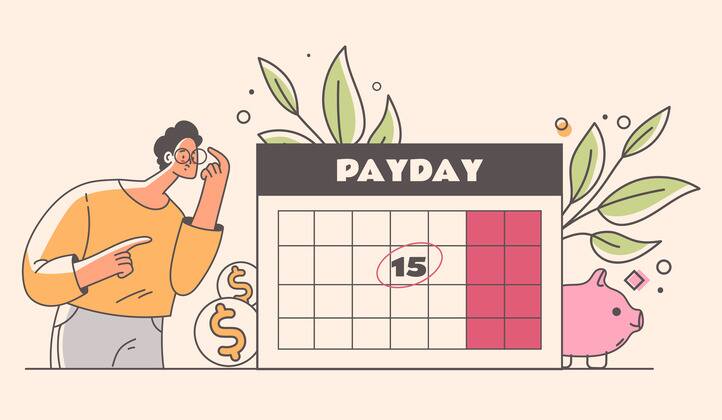What Are Pay Periods, and How Do They Work?

Paying staff seems simple. You calculate how much you owe, make deductions, and write a check. But there’s more to it than that.
You also have to think about pay periods, which define how often you pay employees. While biweekly is the most popular option, there are a few others to choose from. Some businesses even use a combination of lengths to meet everyone’s needs.
So what does “pay period” mean? And how do you decide which one to use? Here’s everything you need to know.
What’s a Pay Period?
A pay period is the length of time between paychecks. During this period, employees earn wages, and at the end of the period, they get paid for their work. Common lengths include weekly, biweekly, and monthly.
But what do your employees prefer? How do you pay fairly without spending too much on deposit and check costs? And how can you use payment schedules to boost morale and retention? Answering these questions can help you identify a pay period.
RELATED ARTICLE — How To Keep Track of Invoices & Payments: A Comprehensive Guide
7 Different Types of Pay Periods

Here are seven possible pay periods:
1. Weekly Pay Periods — 52 per Year
How does weekly pay work? This period cycles every week. It’s most common for companies that have naturally high turnover or need seasonal workers. Fields include construction, retail, and healthcare. Payouts are usually on Fridays, but it depends on what the business decides.
Paying staff this often leads to greater payroll costs because it requires more resources. But it can boost employee retention and help staff pay their own bills on time. One note of caution: Weekly pay can complicate tax reporting because there are more payments to track.
2. Biweekly Pay Periods — 26 per Year
The biweekly cadence is one of the most popular. Paychecks usually come every second Friday. This spreads out payments so employees can better manage their finances throughout the month.
Twice a year, there’s an extra Friday payday in the month, which is a nice bonus for staff. But these “three-paycheck” months can complicate your business’s payroll processes. And you also have to think about leap years. That said, the benefits of a consistent and regular pay schedule usually outweigh the drawbacks.
3. Semimonthly Pay Periods — 24 per Year
The semimonthly pay period is similar to biweekly, but doesn’t have those extra payments at certain times of the year. Instead, staff gets 24 equal payments throughout the year on predictable dates each month. These often happen on the 1st and the 15th, but many businesses opt for the 15th and the last day of each month instead so your staff has money for rent on the 1st.
This payroll cadence makes it easier for both staff and the business to budget. But it can cause headaches if people work overtime. That’s because a workweek may begin in one pay period and end in another, making it hard to calculate overtime correctly.
4. Monthly Pay Periods — 12 per Year
Monthly payments are less common because staff usually don’t like to wait for their paychecks. A whole month is a long time, and the gap between payments makes it harder to budget.
Monthly pay periods usually don’t work for hourly workers because there’s so much counting. This cadence also makes it harder to follow state laws and calculate overtime pay for hourly staff. But monthly payments do have some perks for salaried employees. They simplify taxes, benefits administration, and cash flow management.
5. Fixed-Length Pay Periods
Fixed-length pay periods happen when staff only work for a specific period every time. Teachers, summer camp workers, and other seasonal employees usually get fixed-length pay. This cadence isn’t as common, but it does work well for those who need it. Its flexibility means that an organization can set a schedule that makes the most sense for its operations and staff.
Let’s consider teachers who don’t work in the summer. A school district might only pay teachers over the 10 months of the year they work. They might get 21 paychecks during the standard school year, and then a lump sum payment for the summer.
6. Custom Pay Periods
Custom pay periods fall outside a company’s typical cycle. They’re most common when an employee resigns or works irregular hours. Most states in the US have laws requiring same-day or next-day settlement of these payments.
Custom pay creates a heavier administrative burden for the payroll team. But they give you the flexibility to pay staff in unusual circumstances.
7. On-Demand Pay
Paying staff on a daily basis is rare, due to the high costs and complexity. But there are some payroll apps and systems that let staff access their pay daily. These are called instant pay, on-demand, or earned wage access apps. Employees can take money out of their paychecks in advance, and that money will get deducted from their next paycheck.
Though it’s an unusual way to pay staff, earned wage access is helpful for employees who need their money fast. These apps can also attract staff for short-term needs such as seasonal work.
RELATED ARTICLE — How To State Invoice Payment Terms (With Example Wording)
How To Choose a Pay Period for Your Business

If you’re deciding how often to pay your staff, here are some things to consider:
1. Assess Your Needs
Start by looking at your employees’ schedules. Do they follow a typical workweek of 40 hours? Do their hours change from month to month? Are some staff better classified as hourly workers, while others are on fixed annual salaries? Answering these questions informs what payment frequencies you can handle.
Let’s say you have five full-time staff but bring on two more during busy seasons. You might opt for a combined system: biweekly pay for regular employees and fixed-length pay for seasonal ones.
2. Consider Legal and Regulatory Requirements
In the US, each state dictates the minimum frequency of payments. For example, in Minnesota, you have to pay employees at least every 31 days. Look up the regulations in your area to make sure your choice follows the law.
If your business operates in many states, there may be several sets of rules to consider. Also, federal law asks all employers to calculate overtime on a weekly basis. That means weekly and biweekly payment schedules are best for staff who work overtime often.
3. Understand Employee Preferences and Needs
Money troubles can have massive impacts on employees’ mental health and performance. Your payment schedule should suit their needs as much as possible.
Use surveys and focus groups to understand what staff need and expect. Settle on a pay schedule that works for the business while reducing stress for everyone involved.
4. Evaluate the Financial Implications
Frequent payment cycles may boost employee morale and loyalty. But more transactions mean more work for you or your accounting team. For example, it’s harder to manage tax withholdings on a shorter pay cycle. More frequent pay cycles could also lead to fluctuations in cash flow.
RELATED ARTICLE — How To Accept Payments Online (Credit, PayPal, QR Codes+)
FAQs

Still not sure how pay periods work? Here are some frequently asked questions.
How Many Pay Periods Are in a Year?
The number of pay periods in a year depends on the pay schedule:
- Weekly — 52 pay periods
- Biweekly — 26 pay periods
- Semimonthly — 24 pay periods
- Monthly — 12 pay periods
What’s the Difference Between Weekly and Biweekly Pay Periods?
In a weekly pay period, employees receive a paycheck every week (52 per year). In biweekly pay periods, employees are paid every other week (26 paychecks per year).
How Many Biweekly Pay Periods Are in a Year?
There are 26 biweekly pay periods in a year because there are 52 weeks total. This pay schedule means that in most months, employees receive two paychecks. But twice a year, they get three in a month because of the way the calendar days fall.
Is It Better To Get Paid Monthly or Biweekly?
This is a matter of personal preference. It depends on the employer and employee’s financial situation. Most people prefer biweekly pay because more frequent checks can help them budget better. But it’s the same amount as monthly pay, just split in two.
Can You Have Different Pay Periods for Different Employees?
Yes, your businesses can have two or more pay periods for different staff. It depends on the nature of their work, the employees’ preferences, and legal requirements. You might pay hourly workers on a weekly or biweekly basis due to overtime, and pay salaried employees monthly for ease.
Offer Your Clients Simple Ways To Pay
Paying employees is one thing. Receiving money from customers and clients is another. If you want to make payments as easy as possible, use Invoice Simple. With its online payment processing system, clients can pay directly from their invoices. It’s secure, cost-effective, and quick.
Start Your First
Invoice Today
Create customized and professional
invoices and connect with clients
